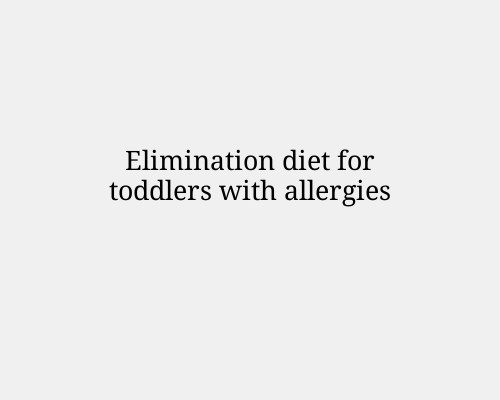
Elimination diet for toddlers with allergies
Food allergies and intolerances are increasingly common in toddlers, and one of the main diagnostic and management tools is an elimination diet. This is a short-term, structured eating plan designed to identify foods that trigger allergic reactions or sensitivities. Since toddlers are still developing physically and nutritionally, elimination diets must be approached carefully under medical supervision.
What Is an elimination diet?
An elimination diet involves removing certain foods that are suspected allergens or irritants from your child’s diet for a set period (usually 2–6 weeks). After symptoms improve, the foods are reintroduced one at a time to see which ones cause reactions. This helps pinpoint which foods should be permanently avoided.
Common food allergens in toddlers
While any food can cause an allergic reaction, the majority of toddler food allergies are linked to:
Milk and dairy products
Eggs
Peanuts
Tree nuts (almonds, cashews, walnuts, etc.)
Soy
Wheat (gluten-containing grains)
Fish and shellfish
These are often referred to as the “top 8 allergens”, and they account for most childhood allergic reactions.
Signs that may indicate a food allergy
Parents may be advised to consider an elimination diet if their toddler shows persistent issues such as:
Eczema or skin rashes
Chronic diarrhea or constipation
Gas, bloating, or stomach pain
Vomiting after eating certain foods
Frequent respiratory issues (congestion, wheezing) not linked to infections
Irritability, poor sleep, or feeding difficulties
Steps to follow in an elimination diet
Consult a paediatrician or allergist
Never start on your own—toddlers need balanced nutrition for growth. A specialist can guide food choices and provide safe alternatives.
Plan the elimination phase (2–6 weeks)
Remove all suspected allergens completely.
Read labels carefully (allergens are often hidden in processed foods).
Keep meals simple with whole foods to minimize accidental exposure.
Monitor symptoms
Track your toddler’s symptoms daily—skin, digestion, behaviour, and breathing. Note improvements or worsening after foods are removed.
Reintroduction phase
Add one food back at a time (every 3–5 days).
Start with small amounts, then gradually increase.
Watch for reactions within 24 -72 hours.
Long-Term management
Once the trigger food is identified, eliminate it permanently. A dietitian can help ensure your child still gets proper nutrition.
Nutrition concerns during elimination diets
Eliminating major foods can put toddlers at risk of nutrient deficiencies. Common concerns include:
Calcium and vitamin D: if dairy is removed
Protein: if multiple allergens (milk, eggs, nuts) are excluded
Iron and B vitamins: if wheat/gluten is eliminated
Healthy fats: if nuts or eggs are removed Safe substitutes may include:
Fortified dairy alternatives (soy, oat, rice, or almond milk—if tolerated)
Lean meats, poultry, and fish (if not allergenic)
Lentils, beans, and peas for plant-based protein
Fruits, vegetables, and whole grains for fiber and micronutrients
Safety considerations
Never try a broad elimination diet without professional guidance. Severe restrictions can harm growth.
Keep emergency medication available if your child has a diagnosed allergy (e.g., epinephrine auto-injector).
Don’t delay reintroduction too long. Prolonged avoidance without true allergy confirmation can sometimes increase sensitivity.
When to seek immediate help
If your toddler experiences symptoms like difficulty breathing, swelling of lips/tongue, or hives after eating, this is an anaphylactic emergency—call emergency services right away.
Final thoughts
An elimination diet can be a powerful tool for identifying food allergies or intolerances in toddlers, but it must be done methodically and with medical supervision. The key is balancing safety, accurate identification of triggers, and maintaining proper nutrition for healthy growth.